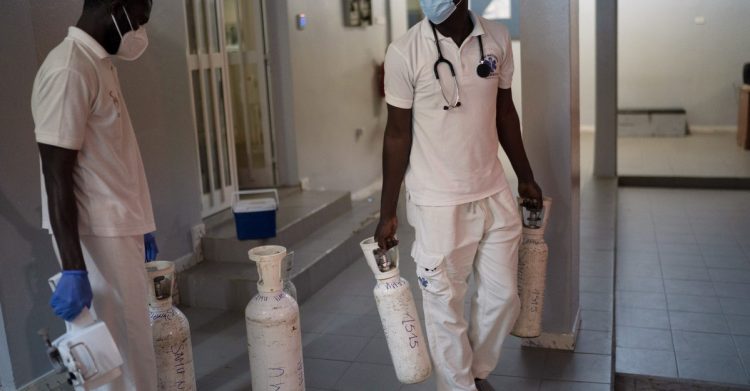A version of this article was originally published in Undark Magazine.
On a late April afternoon, the Ngor Health Center in Dakar, Senegal, is serene. Sunlight spills through architectural gaps in the ceiling and lush plants line cream-colored corridors. In a patient waiting area on the second floor, a staff member gently rolls a ball back and forth with a toddler.
The calm belies the chaos at the health center eight months prior, in the summer of 2021, when COVID-19 struck the West African nation in its third and deadliest wave. The only reminder exists high up on the walls: slim copper pipes trained through roughly drilled holes. The pipes were built as Ngor frantically retrofitted its waiting area with extra beds in a bid to extend the center’s limited oxygen network to treat the influx of COVID patients.
But to the pediatrician Idrissa Demba Ba, the scramble for oxygen—which, in many countries, came to symbolize the pandemic—was nothing new. In fact, it’s a hallmark of another scourge he’s been battling for 18 years, childhood pneumonia. The disease, caused by an infection of the lungs that disrupts breathing, killed 2,400 Senegalese children under the age of 5 in 2019.
Pneumonia can be triggered when a pathogen—for instance, a virus, bacteria, or fungus—enters the lungs, where it inflames the air sacs, causing them to fill with fluid or pus and making it hard to breathe. Children are more vulnerable to the disease because their lungs and immune systems are still developing. To treat the condition, there are three main options: antibiotics, antivirals, and oxygen. Every day, there are children who need to be connected to an oxygen supply, says Ba, who is head of pediatric pulmonology at Dakar’s Albert Royer National Children’s Hospital.
The World Health Organization lists oxygen as an essential medicine, which seems intuitive for a vital, life-sustaining gas. Yet in Senegal and many other developing countries, providing oxygen in its medical form can be fraught: The medical-grade oxygen is expensive, getting it from one place to another requires the construction of pipelines and other infrastructure, and medical personnel must be trained to administer it.
These supply-chain obstacles threaten, per one estimate, more than 7 million children in low- and middle-income countries who get pneumonia each year and need oxygen to survive. Limited supplies are part of the reason the disease remains the most common infectious cause of death in children worldwide, claiming the lives of more than 740,000 under the age of 5 in 2019. Younger children are more vulnerable—29 percent of pneumonia deaths occur within the first month of life, and three-quarters within the first year.
Most of those affected live in lower- and middle-income countries like Senegal, where the risk of pneumonia is exacerbated by malnutrition and other issues, says Papa Birane Mbodji, the head of newborn health at the Department of Mother and Child Health in Senegal’s Ministry of Health and Social Action. Another threat is the nearby Sahara Desert, which sweeps in huge amounts of dust that contribute to the region’s outsize global burden of young patients.
When there isn’t enough oxygen to treat these children, their lungs fail, eliciting grunts as they try desperately to rake in more oxygen from the air, Ba says—a symptom that echoes the devastating effects of COVID-19. While the world’s attention has been trained on COVID, “you could basically say there is an ongoing pandemic of pneumonia mortality,” says Keith Klugman, an infectious-disease expert who heads the pneumonia program at the Bill and Melinda Gates Foundation.
But there may be an upside: The crisis of the coronavirus pandemic drew the world’s attention to the crucial importance of oxygen. Seeing how quickly countries galvanized to tackle COVID, Klugman and other experts wrote a Lancet article in November 2020, calling for them to build on the pandemic’s rare gains—such as increasing oxygen infrastructure—to help curb childhood pneumonia. The authors wrote: “The COVID-19 response provides opportunities to increase diagnostic and treatment services for respiratory infections.”
Ba and other experts on the ground share the sentiment. More and more, they see COVID as an opportunity to get the essential resource to more children, to tackle this forgotten epidemic.
Against this backdrop, Senegal offered fertile ground for improvement. Even before the pandemic, and in the midst of it, the country was interrogating its medical-oxygen infrastructure.
“The government of Senegal established an ambitious scale-up strategy for oxygen as early as 2013,” wrote Lisa Smith, the access-to-medical-devices portfolio director for the market-dynamics program at the public-health nonprofit PATH, in an email to Undark. Then in 2017, she wrote, members of the Senegalese government attended a PATH-led meeting focused on widening oxygen access. There, the government highlighted its work with a private contractor to install and maintain pressure-swing adsorption, or PSA, plants—which produce purified oxygen from ambient air on-site—at a number of hospitals. After this event, Smith said, PATH started working with the government to offer additional support to close other gaps in Senegal’s oxygen-supply chain.
A year into the pandemic, PATH published a report based on a nationwide survey of medical equipment, focused on oxygen infrastructure, noting where it was available and where it was most lacking.
Key among the findings of the resulting report was that oxygen was heavily concentrated at emergency centers in large urban areas, but much scarcer at smaller health centers and posts that serve the majority of the population. For instance, of 29 COVID-treatment centers surveyed across 13 regions, Dakar, Senegal’s capital, had the highest concentration of key medical tools—62 percent of pulse oximeters, which estimate blood oxygen levels, and 84 percent of functional ventilators—despite the city making up less than a quarter of the country’s population.
The equipment survey also revealed stark disparities in the distribution of PSA plants, which provide a reliable supply of oxygen. Nearly half of the treatment centers with access to a PSA plant, which cost upwards of $100,000 apiece, were concentrated in Dakar to meet the needs of the city’s dense population—such as the Ngor Health Center’s PSA plant, which was built there before COVID hit and became a boon during the pandemic.
Within a large, sun-drenched courtyard on the hospital grounds, the PSA plant hums inside a locked concrete enclosure. As part of the setup, there is a black box called a compressor, which sucks in external air and pressurizes it. From there, the pressurized air is scrubbed as it runs through a filtration device to remove nitrogen and allow oxygen to pass through. The oxygen is then transferred to holding tanks, ready to be piped into the wards.
In contrast, at most other health-care facilities where PSA plants are in short supply, health-care workers rely on smaller pieces of equipment such as oxygen concentrators and cylinders to supply the crucial gas. These come with their own challenges: Most concentrators, which are portable, suitcase-size machines, deliver oxygen at a rate that’s too slow for severe COVID patients, and cylinders can be refilled with new oxygen only at centralized plants, which means that supply can be disrupted because of unreliable transport.
Maintaining this piecemeal infrastructure can also be impractical. At another health facility across town, this was evidenced by a pile of discarded concentrators strewn amongst other items—unused respirators in water-logged boxes, mosquito nets, and an old mat and metal bed frame stripped bare—stacked under a zinc roof just outside the entry ramp for emergency patients.
Such infrastructural challenges aren’t unique to Senegal. A 2021 WHO technical consultation revealed that before the pandemic, the majority of low- and middle-income countries struggled to obtain medical oxygen. In sub-Saharan countries, 31 percent of facilities had interrupted access, while 25 percent had none at all.
These wider findings on oxygen and COVID also helped inform child-pneumonia initiatives, including a clinical trial designed to test the value of pulse oximeters in these patients. The trial, part of a project called Tools for Integrated Management of Childhood Illness, or TIMCI—jointly run by PATH, Unitaid, and the Swiss Tropical and Public Health Institute—launched in August 2021 in multiple facilities in three countries, including the arid baobab-studded region of Thiès, an hour’s drive into the countryside beyond Dakar. Here, TIMCI supplied pulse oximeters to doctors at 59 health posts to diagnose incoming patients. As of September 2022, TIMCI has screened almost 17,000 sick children in Thiès.
The devices work by attaching to a patient’s finger and painlessly measuring the level of oxygen in their blood. It’s a quick and inexpensive way of detecting a condition in which oxygen saturation levels dip dangerously below 90 percent, called hypoxemia. Hypoxemia increases the risk of death by pneumonia up to five times.
The Senegalese trial—part of a larger multicountry initiative also involving Kenya, Tanzania, India, and Myanmar—intends to evaluate the effectiveness of pulse oximeters in more accurately and swiftly diagnosing hypoxemia, in order to then help children get the urgent oxygen treatment that they need and save lives. But such initiatives will only ultimately be effective if the essential oxygen supplies are on hand nearby.
On a tree-lined street in downtown Dakar, Ndèye Astou Badiane sits inside the PATH regional headquarters contemplating the pandemic’s legacy. In Senegal, although the health system struggled with a real “increase in demand [for] oxygen,” says Badiane, who is a respiratory-care coordinator at the nonprofit, some good came out of it. The clear and urgent need, she adds, injected new momentum into national efforts to tackle oxygen shortages.
For instance, the government, together with PATH, is now finalizing another assessment of its oxygen infrastructure, maintenance, and long-term sustainability. The overarching aim is “to improve oxygen availability and utilization in each health facility,” Badiane wrote in a follow-up email.
This evolving assessment laid the foundation for the government’s most significant move: the plan to roll out dozens of new PSA plants, the units that produce oxygen on-site at hospitals, says Amad Diouf, the director of the Department of Infrastructure, Equipment, and Maintenance at Senegal’s Ministry of Health and Social Action. These crucial new oxygen plants, five of which are funded by UNICEF, are due to be installed by the end of 2022, with a focus on health centers across the country. At the start of the pandemic, with support from PATH and Unitaid, Senegal was able to acquire 175 oxygen concentrators, 1,000 oxygen masks, and 250 pulse oximeters.
There are early indications that the effort to strengthen Senegal’s oxygen gaps is translating into gains in the fight against childhood pneumonia. A 2021 review study found that bolstering oxygen infrastructure in lower- and middle-income countries could cut child-pneumonia deaths in hospitals by almost half. And in Senegal, the pediatrician Mbodji says there has been a notable increase in the availability of oxygen at health facilities. Though it’s difficult to attribute solely to this change, Mbodji says, pneumonia deaths in children have declined over the past two years.
The pandemic has also given pneumonia initiatives like TIMCI special resonance. COVID-19 was “an opportunity” for the Ministry of Health to recognize the importance of oxygen infrastructure and accelerate the spread of lifesaving tools like pulse oximeters through more health facilities, says Maymouna Ba, who leads the TIMCI project in Senegal.
“Before TIMCI, before COVID-19, such equipment, such tools, were just available at higher levels like in hospitals, in health centers. But not in health posts where providers also need these kind of equipment, these kind of tools to better detect severe illness in the early stage,” Ba says. With the TIMCI trial ongoing, she adds, there are plans to eventually provide even more pulse oximeters to health posts across the whole country.
Other pneumonia interventions have received a similar boost in recognition—such as the SPRINT project, or Scaling Pneumonia Response InnovaTions, a program run by UNICEF to expand access to antibiotics and oxygen treatment for pneumonia. The program was originally confined to certain regions, but since the pandemic began, Mbodji says, the government has been working on plans to extend it to the entire country.
Senegal’s oxygen response is emblematic of changes unfolding elsewhere. COVID made plain that “you can’t wait for disaster to happen for the equipment to be here,” says Fatima Diaban, a critical-care physician and member of the Every Breath Counts Coalition, an initiative by the nonprofit JustActions focused on supporting national governments in reducing pneumonia deaths by the end of the decade. In May 2021, Senegal was among nine African nations to begin receiving help from PATH and the Clinton Health Access Initiative to procure new oxygen equipment, funded by $20 million from Unitaid. The Global Fund, an international health-care-focused funding organization, with support from government and private-sector donors, also provided $475 million to 66 lower- and middle-income countries for a similar purpose.
Now that the pandemic has eased, some of these resources can be redeployed to treat childhood pneumonia—something that’s already under way in other countries such as Ethiopia, where the government announced plans in 2021 to redistribute the pulse oximeters and oxygen therapies it used for COVID elsewhere in its health-care system.
Large aid donations often come with questions about whether such funding reaches the intended recipients in its entirety. PATH’s Smith said there are safeguards in place to ensure it does. “Each donor has unique requirements for accountability and responsible use of funds,” she wrote in an email. For instance, her organization worked closely with Senegal’s Ministry of Health and the Department of Infrastructure, Equipment, and Maintenance to distribute donated oxygen equipment to facilities in need.
Overall, such initiatives could fast-track progress on pneumonia, a disease that’s still “very much neglected” in the global health discourse, despite its global burden, says Klugman of the Bill and Melinda Gates Foundation. Pneumonia is still chronically underfunded, taking just 5 percent of the money devoted to fighting infectious disease globally, and just 3 percent of the research funding allocated to infectious diseases from 2000 to 2017 by public and philanthropic funders in G20 countries.
Prevention will be crucial—and progress is under way to develop new, targeted vaccines, which protect better against pneumonia compared with existing vaccines, Klugman says. But for now, oxygen remains a uniquely efficient way to save lives. As such, the pandemic responses that many countries have drawn up provide an ideal framework for action—a “foundation for continued declines in deaths from all-cause respiratory infections over the next decade,” according to a 2021 report on pneumonia and the coronavirus pandemic produced by JustActions.
Indeed, it’s not just children with pneumonia who stand to benefit from this spread: Wider oxygen provisions will aid people with infectious diseases, cardiovascular diseases, and asthma.
This larger importance, laid bare and elevated by the pandemic, is behind the recent September 2022 launch of the Lancet Global Health Commission on medical oxygen security, a new partnership of academics and NGOs, which will reportedly include strong representation from lower- and middle-income countries. The commission seeks to build on the pandemic’s gains and provide policy makers with information and tools to close the crucial gaps in global oxygen-supply chains.
Already, the benefits of expanded oxygen access are evident at the Ngor health center, where the copper pipes are reminders of a traumatic time but now stretch beyond the emergency room, ferrying oxygen to those who need it most. Just off the main corridor of the second floor, those pipes have been trained into a room with walls decorated with cheerful stickers of Dora the Explorer, flowers, and birds—a children’s ward.
As Badiane puts it: “In 2022, really oxygen should be available and affordable in every health facility.”
Source by www.theatlantic.com











